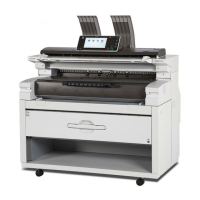If the network area provides poor radio environment
Where radio wave conditions are bad, the network may not function due to interrupted or failed
connections. When checking the wireless LAN signal and the access point, follow the procedure
below to improve the situation:
• Position the access point nearer to the machine.
• Clear the space between access point and machine of obstructions.
• Move radio wave generating appliances, such as microwaves, away from the machine and
access point.
• For information about how to check radio wave status, see “Checking the signal”, General Settings
Guide.
• For more information about access point radio wave conditions, refer to the access point manual.
Configuring WPA/WPA2
WPA/WPA2 uses an authentication server to provide greatly enhanced security compared to WPA-PSK/
WPA2-PSK.
WPA/WPA2 can be configured using Web Image Monitor's administrator mode. You can select four types
of EAP authentication method: EAP-TLS, LEAP, EAPTTLS and PEAP. Note that each EAP authentication
method has different configuration settings and authentication procedures.
Types and requirements of certificates are as follows:
If a certificate is required, configure all settings after installing the certificate.
EAP Types Requiring a “Site Certificate”
EAP-TLS, EAP-TTLS, PEAP (Necessary except LEAP)
EAP Types Requiring a “Site Certificate” and a “Device Certificate”
EAP-TLS, PEAP (Phase 2 is for TLS only)
• To set WPA/WPA2, you must enable SSL. For details about setting SSL configuration, see “Protection
Using Encryption”, Security Reference.
• To set WPA/WPA2, you must use Web Image Monitor.
Installing a Site Certificate
1. Access the authentication server and obtain the CA certificate.
Methods of obtaining certificates differ according to the operating system you are using.
2. Log on to Web Image Monitor in the administrator mode.
4. Appendix
152

